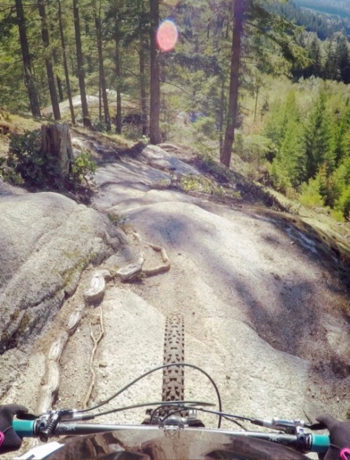Take the risk or lose the chance
Many of life’s greatest achievements require stepping outside our comfort zone. Whether it’s tackling a technical trail feature, overcoming a fear of starting a business, investing money in your future, or putting yourself out there for a relationship—many of life’s most rewarding experiences come as a result of taking risks.
The fear of doing something wrong is a huge factor that holds people back, and so we often choose the safer approach and just stick with what’s worked in the past. The question is what is good risk-taking and what is bad?
Daredevil or well-practiced risk-taker
It’s common to view risk-takers as daredevils with an innate desire for a thrill, but when you start taking risks, you can realize the biggest wins. Risk-takers understand that success doesn’t fall in your lap — you have to pursue it. They learn to push their limits and accept take setbacks in stride, without taking it to heart.
You can endlessly identify the risk of loss against the potential benefits, but a surefire path towards progress is through accepting some risk, and potentially some failure too. Practicing failure isn’t a bad thing though — it’s actually an essential tool for building character. Failure makes us stronger and more resilient, and those who fail repeatedly develop the strength to persist in the face of difficulties.
“He who is not courageous enough to take risks will accomplish nothing in life.” -Muhammad Ali
One example of a successful risk-taker is billionaire and founder of SPANX, who shares that part of her success was attributed to her mindset of “Try everything and push the envelope. Behind every incident of failure is an opportunity or lesson.” Genius is one percent inspiration and 99 percent perspiration…you have to be willing to be steadfast in the face of challenges and setbacks.
Calculated Risk or Gamble
Don’t leap into every opportunity that presents itself. The trick to good risk-taking is to learn everything you can about the things you take chances on, that way you’re able to take only the most calculated risks. You must become relentless about learning.
The key difference between a risk and a gamble is the knowledge you have. A gamble puts something in jeopardy and a calculated risk puts something to work. If you’re attempting a new trail to progress your skills, that would be a calculated risk; if you’ve just bought a mountain bike and decide to ride an expert level feature, that’s a gamble.
Successful risk-takers spend time considering the decision, they weight the pros and cons, and they’re mindful of balancing the hazards without killing a great idea.
Practice pays off
Harvard Business Review discusses how, “business courage is not so much a visionary leader’s inborn characteristic as a skill acquired through decision-making processes that improve with practice.” Successful leaders aren’t just born with an ability to make high-risk decisions—it is a skill they honed over many years of experience.
If you can become well-practiced at failure and good at identifying potential problems, you’ll be in a better position to explore the spaces between them.
Calculating
Winning in risky situations often requires being what you haven’t been, thinking as you haven’t thought, and acting as you haven’t acted. We might overestimate our chances of success or failure, but what’s really interesting is that we underestimate our ability to deal with unfavourable outcomes.
When looking into the future, we come up with dramatic worst-case scenario’s in our minds-eye and disregard the cost of taking no action at all. When calculating your risk, don’t catastrophize, but think deeply about how you could handle the possible problems and explore plan B scenarios.
Short term pessimist, long-term optimist
One doesn’t even begin to plan a 500 mile bike race unless one is an optimist. This same confidence can be deadly in the wrong circumstances. Once the training has begun, skepticism is the preferred attitude. You have to conjure up the things that could go wrong—what if the weather shifts? What if I have mechanical issues? Best to be skeptical and plan for the worst. Only a foolhardy optimist would deny the potential headwinds. But only a foolhardy pessimist would deny the wonderful opportunities that lie ahead.
When many people decide to sign up for a race, they get very optimistic about their success. Unfortunately when they realize that successfully completing one requires months of training— and even then no amount of success is guaranteed—these people often give up.
The key to using pessimism is to use it in the short-term only. Long-term pessimism would be if you believe your life will never get better or things will never work out, which is the paralyzing effect of pessimism. If you plan to start a business, and have short-term pessimism that says failure is highly probably, and that you will need to work your butt off to succeed, that’s a good way to stay in the game. If you’re in a relationship and consider the potential challenges, you’re better able to come up with strategies to avoid or deal with those bad things, and it helps direct anxiety toward productive activity.
Good Risk
People who realize remarkable success and who become notable leaders, usually have a greater than average willingness to make bold moves. The truth is everything we do has a downside. It’s not hard to find it. Successful risk-taking isn’t without a some calculation and consideration, and there are a few components of taking good risks, which are:
- Ask yourself “What would success look like in this high-risk situation?”
- Does this risk have a high percentage of developing or deepening skills that will transfer to other things, even if the current thing fails?
- How important is it that you achieve your goal?
- Will this risk help me develop relationships that can transcend the current situation?
- Will this risk help me develop emotional resilience and that demystify fearful situations?
- What if everything goes well?
- What if everything goes wrong?
- Will the risk of rejection in being vulnerable be worth it to allow someone to get closer to you, and deepen your bond?
- If I do this, what potential outcomes could I expect?
- What will I potentially gain long-term by taking this risk?
Bad Risk
Difficult experiences teach us things we need to know. It’s important to not confuse risk with stupidity—health, financial and legal risks, are among the areas to be more risk-averse.
- Risk taking isn’t about jumping on every opportunity; it’s about taking the educated ones.
- Your goal isn’t to blindly risk your career, your life savings or your life, but rather to weigh your risk/reward and maximize your chances of success.
Determination
When risk-taking, most people make only one attempt: They show up, ring the doorbell, and if they don’t get the answer they wanted, they give up and go away. Those who realize their vision don’t give up that easily, they knock at the back door, throw rocks at the window, and try again a second or third time.
Perspective
It’s important to not judge yourself on whether you succeed or not, but rather on whether you have the guts to risk failure in the first place. Taking risks opens up your mind to abilities that you didn’t know you had…





No Comments